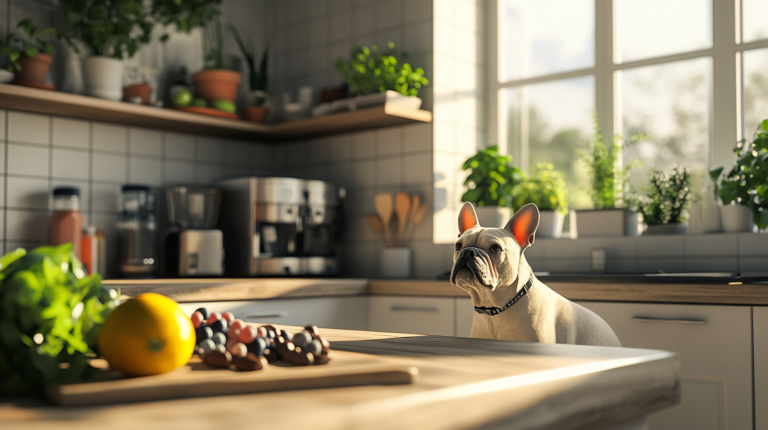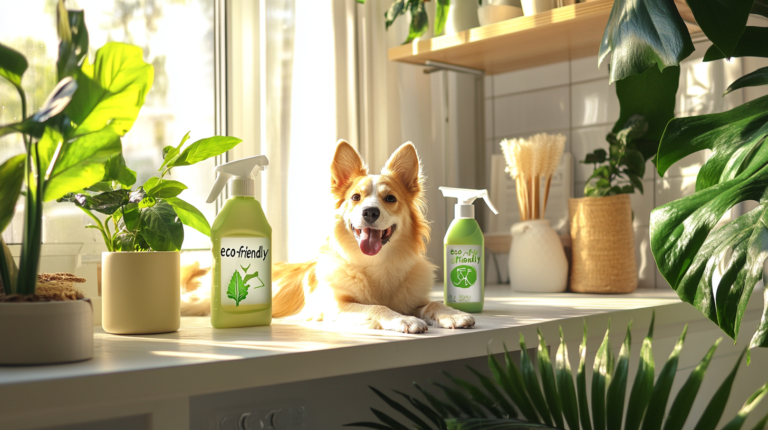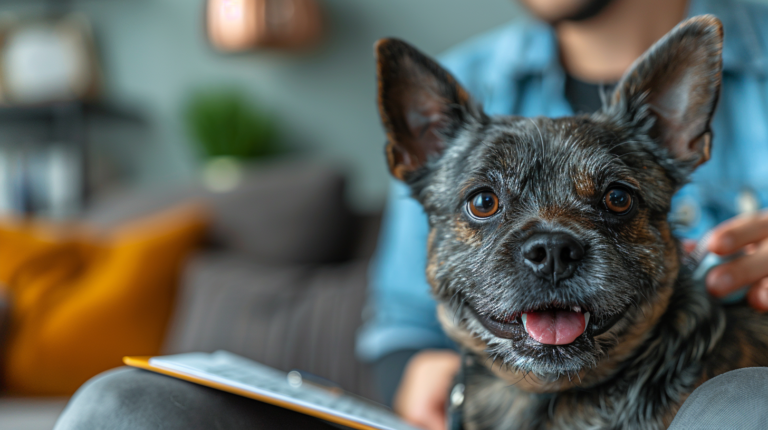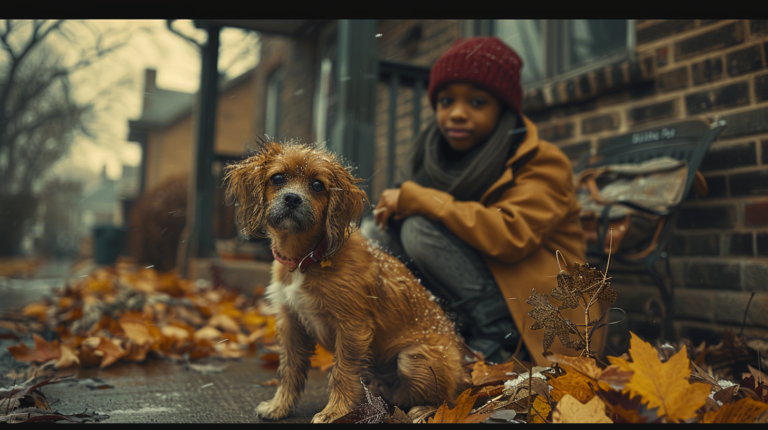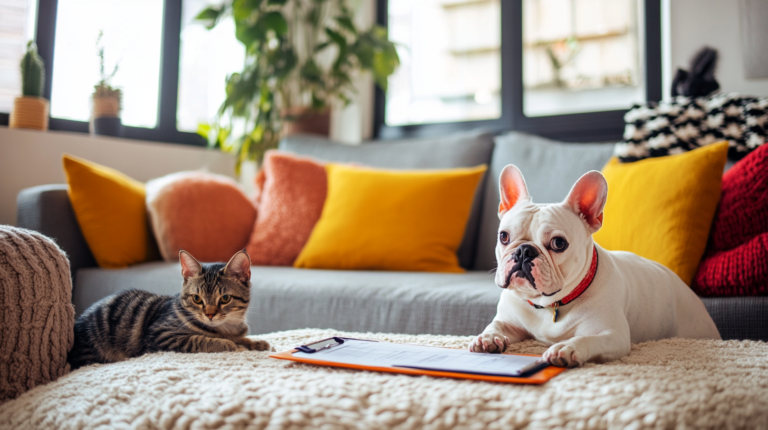Discover 7 essential cleaning tips for pet owners to maintain a spotless, odor-free home. From tackling pet hair to eliminating stains, learn professional strategies for living harmoniously with pets.
Table of Contents
Living with pets brings immeasurable joy, companionship, and love to our homes. However, along with the cuddles and playtime comes an often-overlooked challenge: keeping your living space clean, fresh, and hygienic. As devoted pet parents, we understand the struggle of maintaining a spotless home while sharing it with our furry, feathered, or scaled companions. That’s why we’ve compiled these comprehensive cleaning tips for pet owners that will transform your cleaning routine and help you maintain a healthy environment for both you and your beloved pets.
Whether you’re battling persistent pet hair, unexpected accidents, or that distinct pet odor that seems to permeate everything, this guide offers practical solutions that are effective, pet-safe, and environmentally friendly. From daily maintenance strategies to seasonal deep cleaning approaches, we’ve covered all aspects of pet-related housekeeping challenges.
Understanding Your Pet’s Impact on Home Cleanliness
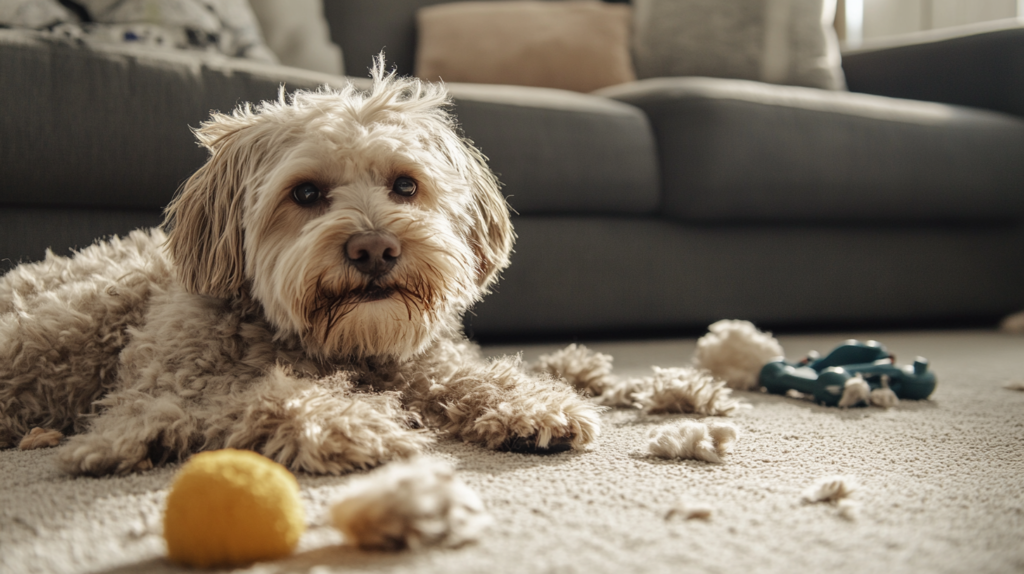
Before diving into specific cleaning tips for pet owners, it’s essential to understand how your pets interact with their environment and the unique cleaning challenges they present.
Shedding Patterns and Management
Different pets shed at varying rates and seasons. According to a 2024 study by the American Pet Products Association, homes with pets can accumulate up to 40% more dust and allergens than pet-free homes. This is largely due to pet dander—tiny, even microscopic, flecks of skin shed by cats, dogs, birds, and other animals with fur or feathers.
Dogs typically experience heavy shedding twice a year (spring and fall), while indoor cats may shed year-round. Understanding your pet’s shedding cycle helps you anticipate and prepare for periods of increased cleaning needs.
Behavioral Factors Affecting Cleanliness
Pet behavior significantly impacts home cleanliness. For instance:
- Territory marking through scratching or spraying
- Tracking in dirt from outdoors
- Food scattering during meal times
- Toy distribution throughout living spaces
- Accident-prone areas during training or illness
Dr. Jessica Martins, veterinary behaviorist at the National Pet Behavior Center, notes: “Many pet-related messes are actually extensions of natural behaviors. Understanding why your pet does what they do is the first step to creating an environment that minimizes cleaning challenges while respecting your pet’s instincts.”
Health Considerations
Maintaining a clean home isn’t just about aesthetics—it’s about health for both humans and pets. According to the Centers for Disease Control and Prevention (CDC), pets can carry and spread over 60 diseases to humans (zoonotic diseases), many of which can be minimized through proper cleaning and hygiene practices.
Additionally, pet allergies affect approximately 10-20% of the global population. Regular, thorough cleaning can significantly reduce allergen concentration in homes with pets.
Essential Cleaning Supplies for Pet Owners
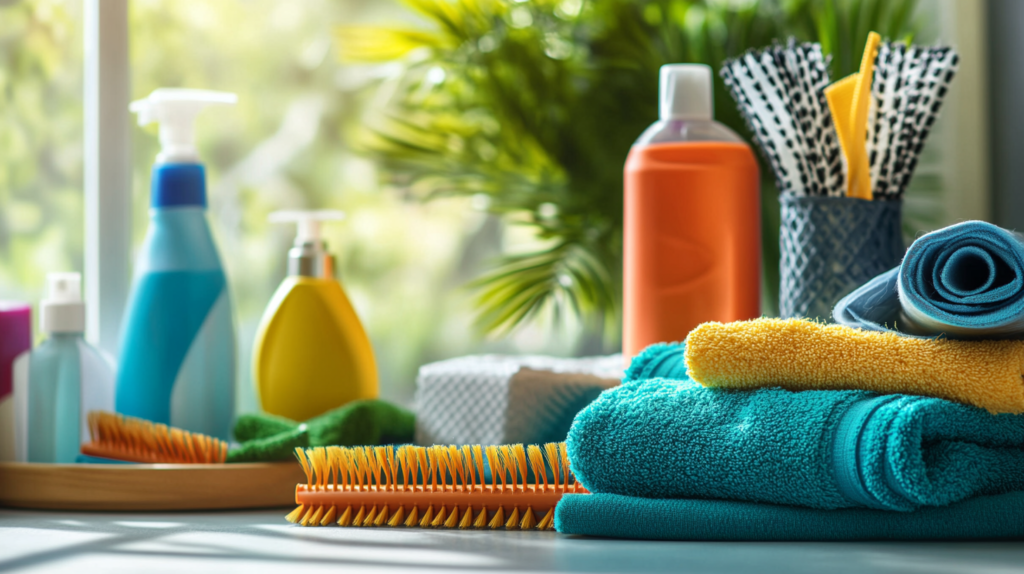
Having the right tools makes pet cleaning significantly more efficient. Here’s a comprehensive list of must-have cleaning supplies specifically designed to address pet-related messes:
Vacuum Technology
Investing in a high-quality vacuum designed for pet hair is perhaps the most important cleaning tool for pet owners. Look for features like:
- HEPA filtration (captures 99.97% of particles as small as 0.3 microns)
- Specialized pet hair attachments
- Strong suction capability
- Tangle-free brush rolls
- Bagless options with easy-empty canisters
In a 2024 Consumer Reports study, vacuums specifically designed for pet hair removal performed 35% better at capturing embedded pet hair compared to standard models.
Enzymatic Cleaners
These specialized cleaners use biological enzymes to break down organic matter (urine, feces, vomit, blood) at the molecular level, making them essential for accident cleanup.
Dr. Amanda Chen, certified veterinary toxicologist, explains: “Enzymatic cleaners don’t just mask odors—they actually break down the proteins in biological messes that traditional cleaners can’t touch. This is why they’re particularly effective for eliminating both visible stains and invisible odor molecules that pets can still detect even after standard cleaning.”
Top-rated enzymatic cleaners include:
- Nature’s Miracle Advanced Pet Trigger Sprayer
- Rocco & Roxie Professional Strength Stain & Odor Eliminator
- Biokleen Bac-Out Stain & Odor Remover
- Simple Solution Extreme Pet Stain & Odor Remover
Microfiber Technology
Microfiber cloths and mops capture pet hair and dander more effectively than traditional cotton alternatives because:
- The split fibers create more surface area for trapping particles
- They can be used wet or dry
- Many are machine washable and reusable
- They typically don’t require chemicals to be effective
Pet Hair Removal Tools
Beyond vacuuming, these specialized tools make pet hair removal more efficient:
- Rubber brooms (electrostatic properties attract hair)
- Pet hair removal brushes for furniture
- Reusable pet hair rollers
- Silicone or rubber gloves (simply wet, run over surfaces, and rinse)
- Squeegees for carpet and upholstery
Air Purification Systems
HEPA air purifiers can remove up to 99.97% of airborne pet dander, helping to maintain better air quality between deep cleanings. Look for models specifically designed to address pet odors, which often incorporate activated carbon filters.
Pet-Safe Cleaning Products
Many conventional cleaning products contain chemicals that can be harmful to pets, who may walk on treated surfaces and then lick their paws. Essential pet-safe cleaning alternatives include:
- Distilled white vinegar (diluted 1:1 with water)
- Baking soda for odor absorption
- Hydrogen peroxide (3%) for stain treatment
- Steam cleaners that use heat rather than chemicals
- Commercial pet-safe cleaning brands like Seventh Generation, Method, or Mrs. Meyer’s
Cleaning Tip: Create a pet cleaning caddy that contains all your essential supplies in one portable container, making it easier to address messes promptly before they become more difficult to remove.
Daily Cleaning Habits That Make a Difference
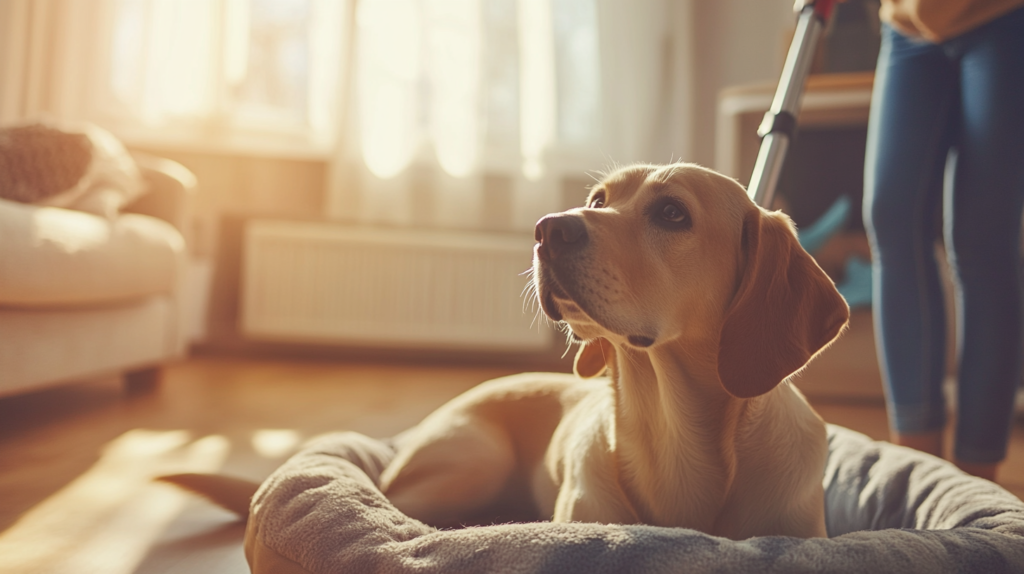
Implementing these daily cleaning tips for pet owners can prevent the accumulation of pet-related messes and make weekly deep cleaning sessions much more manageable:
Entryway Management
Create a “transition zone” at your home’s entrances to catch dirt and debris before it spreads:
- Use absorbent doormats both outside and inside entryways
- Keep a small towel near the door to wipe paws after walks
- Install a pet-specific hand shower near entrances if possible
- Store pet wipes for quick paw cleaning
According to home organization expert Maria Kondo, “The entryway serves as the first line of defense against outdoor contaminants. For pet owners, this area is even more crucial as it can prevent up to 60% of outdoor debris from entering your main living space.”
Strategic Grooming
Regular grooming significantly reduces the amount of hair and dander that ends up on your floors and furniture:
- Brush dogs and cats outdoors when possible (weather permitting)
- For indoor grooming, do it in one easily cleanable location
- Use a grooming mitt or glove in the bath or shower to remove loose fur
- Consider professional grooming every 6-8 weeks for heavy shedders
A 2023 study published in the Journal of Veterinary Dermatology found that daily brushing for just 5-10 minutes can reduce shedding by up to 90% in some breeds.
Bedding Rotation System
Pet bedding quickly accumulates hair, dander, and odors:
- Use removable, washable covers on all pet beds
- Maintain at least two sets of bedding for each pet
- Wash bedding weekly in hot water (130°F/54°C to kill dust mites)
- Consider waterproof liners for pets prone to accidents
Focused Cleaning Zones
Rather than trying to clean the entire house daily, focus on high-impact areas:
- Pet feeding stations (sweep/wipe after each meal)
- Favorite lounging spots (quick vacuum or lint roller daily)
- Litter box areas (scoop at least once daily)
- High-traffic pathways pets frequently use
10-Minute Daily Maintenance Schedule
Even the busiest pet owners can implement this quick daily routine:
TimeTaskBenefit2 minQuick-sweep entry areasPrevents dirt spread3 minSpot-vacuum pet rest areasReduces hair buildup2 minWipe food/water areasPrevents pest attraction3 minLint roll furnitureMaintains appearance
Environmental health researcher Dr. Patricia Olson notes: “Short, consistent cleaning sessions are far more effective than occasional marathon cleaning events. For pet owners, these quick daily touchups prevent the compounding effect of pet hair and dander, which becomes increasingly difficult to remove once it’s embedded in surfaces.”
Tackling Pet Hair: Advanced Strategies
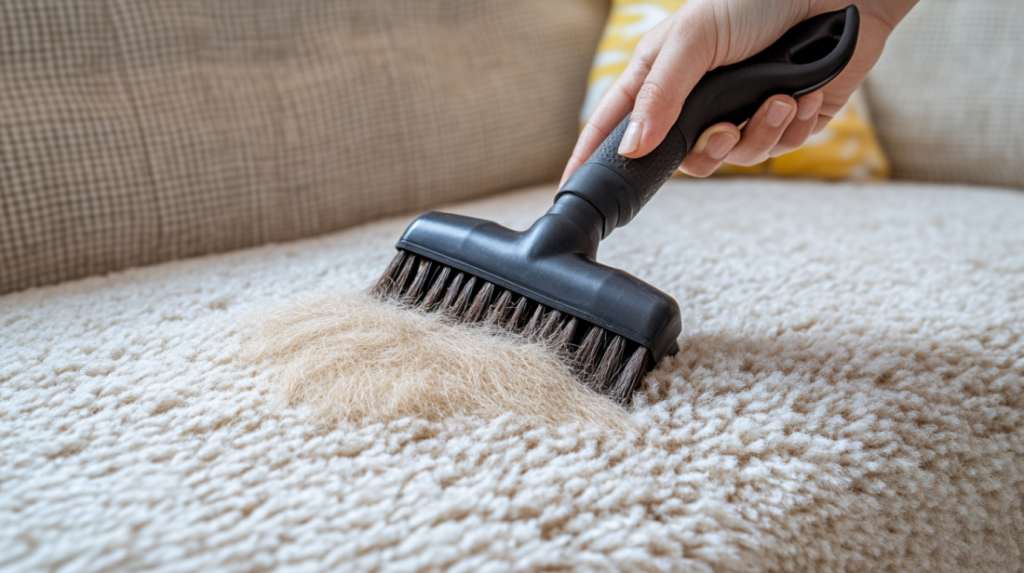
Pet hair management is consistently ranked as the top cleaning challenge for pet owners. These advanced techniques go beyond basic vacuuming to help you get control of even the most persistent shedding:
Surface-Specific Hair Removal Techniques
Different surfaces require different approaches for effective hair removal:
Hardwood/Tile Floors
- Use electrostatic dry mops that attract and hold hair
- Rubber brooms create static electricity that lifts hair from corners
- Vacuum with hard floor setting (brush roll off) to prevent scattering
Carpets and Rugs
- Dampen a rubber broom or squeegee and pull across carpet to collect hair
- Vacuum in multiple directions to loosen embedded hair
- Consider carpet rakes for deep-pile carpeting
- Use the “cross-hatch” vacuum method: first north-south, then east-west
Upholstery
- Dampen rubber gloves and run over furniture surfaces
- Use upholstery brush attachments with short, firm bristles
- Consider furniture covers specifically designed for pet owners
- Apply anti-static spray before vacuuming to make hair release more easily
Preventative Measures for Hair Control
- Apply anti-shedding products recommended by veterinarians
- Supplement pets’ diets with omega-3 fatty acids to improve coat health (consult your vet first)
- Maintain proper humidity levels (30-50%) as overly dry air can increase static and make hair cling to surfaces
- Consider air purifiers with pre-filters specifically designed to capture pet hair
Professional-Grade Solutions
For homes with multiple pets or heavy shedders:
- Robot vacuums designed for pet hair that can run daily while you’re away
- Central vacuum systems with specialized pet hair attachments
- Professional-grade steam cleaners for periodic deep cleaning
- Electrostatic mops that attract and hold hair using static electricity
Veterinary dermatologist Dr. Karen Moriello explains: “Excessive shedding can sometimes indicate underlying health issues. If you notice a sudden increase in shedding, consult your veterinarian. However, for normal shedding, consistent grooming and cleaning routines are your best defense.”
Odor Elimination Techniques That Actually Work
Pet odors can persist even in visibly clean homes. These science-backed approaches target odors at their source rather than simply masking them:
Understanding Odor Chemistry
Pet odors come from various sources:
- Urine (contains urea, urobilin, and uric acid)
- Body oils
- Saliva and drool
- Anal gland secretions
- Bacteria that break down organic matter
Each requires a specific approach for effective elimination.
Deep Cleaning Protocols for Odor Removal
For embedded odors that have penetrated surfaces:
- Carpet and Upholstery Treatment:
- Begin with thorough vacuuming to remove surface debris
- Apply an enzymatic cleaner specifically formulated for the type of odor
- Allow to completely saturate the affected area (including padding underneath)
- Cover with a clean towel and weight down overnight
- Air dry completely before resuming normal use
- Hard Surface Treatment:
- Clean the surface with a pet-safe detergent
- Apply an enzymatic cleaner if organic matter is the source
- For porous surfaces like grout or unsealed wood, use a specialized sealer after cleaning
- Fabric Treatment:
- Pre-treat with enzymatic solution
- Wash at the highest temperature the fabric can tolerate
- Add 1 cup of white vinegar to the rinse cycle
- Avoid dryer sheets (can leave a residue that traps odors)
Natural Odor Control Methods
Research from the Environmental Working Group suggests that many commercial air fresheners contain potentially harmful chemicals. These natural alternatives are both effective and safer for pets:
- Activated charcoal bags placed in pet areas
- Baking soda as a carpet treatment before vacuuming
- Natural zeolite rocks that absorb odors
- Regular washing of pet toys and accessories
- White vinegar spray (the vinegar smell dissipates as it dries)
- Fresh air exchange (open windows when possible)
Specialized Odor Scenarios
Litter Box Management
- Scoop at least 1-2 times daily
- Complete litter change weekly
- Regular box washing with mild, unscented soap
- Consider self-cleaning systems for multi-cat households
- Use activated charcoal filters near litter areas
Wet Dog Smell
- Implement a dedicated drying station with absorbent towels
- Use pet-specific shampoos that control odor-causing bacteria
- Consider microfiber drying coats for quick moisture removal
Veterinary technician Sarah Mills recommends: “For persistent pet odors, think beyond surface cleaning. Odor molecules can penetrate surprisingly deep into materials. Using enzymatic cleaners that continue working after application is often necessary for complete elimination.”
Stain Removal: From Accidents to Tracking
Even the best-trained pets occasionally have accidents or track in substances that can stain your home. These techniques address common pet stains effectively:
Quick Response Protocol
The most critical factor in successful stain removal is time. For any pet accident:
- Blot (don’t rub) excess liquid with absorbent paper towels or cloths
- Apply an enzymatic cleaner appropriate for the surface and stain type
- Allow the enzyme cleaner to work according to package directions
- Blot again to remove dissolved matter
- Rinse with clean water if recommended
- Allow to air dry completely
According to cleaning chemist Dr. Robert Wolfe: “The golden rule for pet stain removal is addressing it immediately. After 24 hours, success rates for complete removal drop by approximately 50%, and after 72 hours, some stains become permanently set.”
Stain-Specific Treatments
Different stains require tailored approaches:
Urine Stains
- Use black light to detect old urine stains
- Apply enzymatic cleaner specifically formulated for urine
- For set-in stains, consider carpet cleaning machines with specialized pet formulas
- For hardwood, assess if urine has penetrated sealant (may require professional restoration)
Fecal Stains
- Remove solid matter with gloved hands or disposable utensils
- Apply enzymatic cleaner formulated for protein breakdown
- For carpets, brush gently after cleaner application to help penetration
- Sanitize the area with pet-safe disinfectant after cleaning
Vomit Stains
- Remove solid matter immediately
- Treat with enzyme cleaner suitable for protein and acid stains
- For carpets with color-fast concerns, test cleaners in inconspicuous areas first
Mud and Dirt Tracking
- Allow mud to dry completely before cleaning
- Vacuum thoroughly to remove dried particles
- Treat remaining stains with appropriate cleaner for the surface
Prevention Strategies
- Apply fabric protectors to upholstery and carpets (ensure they’re pet-safe)
- Use washable runners in high-traffic areas
- Install easy-clean flooring in pet entry areas
- Consider booties for dogs during wet weather
- Use pet wipes near entries for quick paw cleaning
When to Call Professionals
Some stains warrant professional intervention:
- Large-scale accidents that have penetrated to subfloors
- Stains on valuable or antique rugs
- Persistent odors despite multiple cleaning attempts
- Urine damage to hardwood that has caused warping or discoloration
Professional cleaner Marcus Rodriguez advises: “When evaluating whether to DIY or call a professional, consider not just the visible stain but what might be happening beneath the surface. Urine can penetrate carpet backing, padding, and even subfloors, requiring specialized equipment for complete remediation.”
Specialized Cleaning for Different Pet Types
Different pets create unique cleaning challenges. Here are tailored cleaning tips for pet owners of various animal companions:
Dog-Specific Cleaning Solutions
Dogs typically create more varied cleaning challenges due to their size and outdoor activities:
For Short-Haired Breeds
- Weekly brushing with short-bristled brushes
- Monthly bath with dog-specific shampoo
- Daily wipe-downs with pet-safe cloths for breeds that produce more body oils
For Double-Coated Breeds
- Invest in an undercoat rake for use during shedding seasons
- Consider professional deshedding treatments quarterly
- Use high-velocity dryers after baths to remove loose fur
For Active Outdoor Dogs
- Create a “mudroom” transition area with easy-clean flooring
- Keep a specialized dog shower or dedicated bath area if possible
- Use waterless shampoo for quick cleanups between baths
Cat-Specific Cleaning Challenges
Cats present different cleaning considerations:
Litter Management
- Position boxes away from heating/cooling vents
- Consider top-entry boxes to reduce litter tracking
- Use litter mats with raised patterns to catch particles from paws
- For multi-cat households, follow the “n+1” rule (one more box than the number of cats)
Furniture Protection
- Provide appropriate scratching surfaces near favorite furniture
- Use double-sided tape or aluminum foil temporarily to discourage scratching
- Consider clear vinyl furniture guards for areas prone to scratching
Hairball Prevention
- Regular brushing reduces ingested hair
- Clean up hairballs with enzyme cleaner to eliminate residual proteins
Small Mammal Maintenance
For guinea pigs, hamsters, rabbits, etc.:
- Use bedding that controls odor naturally (paper-based products often work best)
- Spot-clean cages daily and full clean weekly
- Install cage guards to prevent bedding scatter
- Position cages away from carpeted areas when possible
Bird-Specific Cleaning
Birds create unique cleaning challenges with seed hulls and feather dust:
- Place clear acrylic seed guards around cages
- Use HEPA vacuums to capture fine feather dust
- Clean perches and toys weekly to prevent bacterial growth
- Consider air purifiers with specialized filters for bird dander
Reptile Habitat Maintenance
For reptile owners:
- Use substrate that controls odor and is easy to spot-clean
- Implement bioactive setups where appropriate to reduce cleaning frequency
- Maintain proper ventilation to prevent mold growth
- Disinfect water features regularly with reptile-safe products
Exotic pet veterinarian Dr. Lisa Abbo notes: “Each pet species has unique cleaning requirements based on their biology and behavior. Understanding these differences allows pet owners to create cleaning routines that address specific challenges rather than using a one-size-fits-all approach.”
Creating Pet-Friendly Cleaning Zones
Strategic organization of your home can significantly reduce cleaning challenges:
Designated Pet Areas
Creating specific zones for different pet activities helps contain messes:
- Feeding Zones
- Use washable placemats under food and water bowls
- Consider elevated feeders with splash guards
- Install easy-clean flooring in feeding areas
- Maintain a 3-foot “splash zone” around water bowls with waterproof solutions
- Sleeping Zones
- Designate specific furniture for pet use or protect with washable covers
- Provide multiple pet beds throughout the home to discourage furniture use
- Use furniture deterrent sprays (ensure they’re pet-safe) for off-limits areas
- Play Zones
- Contain toys in specific areas with easy-clean flooring
- Use washable rugs that can be frequently laundered
- Implement toy rotation systems to prevent clutter
- Grooming Zones
- Create a dedicated space for brushing, nail trimming, etc.
- Use catchment systems for hair during grooming sessions
- Store grooming supplies in waterproof containers nearby
Traffic Flow Management
Analyze your pet’s movement patterns and adjust your home accordingly:
- Identify primary pathways your pet uses and protect those areas
- Consider temporary gates for areas that are difficult to keep clean
- Use runners and washable rugs along main pet routes
- Position furniture strategically to discourage access to difficult-to-clean areas
Smart Storage Solutions
- Store pet supplies in easily accessible, clean containers
- Use airtight containers for food to prevent pest attraction
- Create cleaning stations throughout the home for quick access
- Implement vertical storage to keep items out of pet reach
Interior designer Rebecca Liu, who specializes in pet-friendly homes, suggests: “Think of pet zones as part of your overall home design. When these areas are thoughtfully integrated rather than afterthoughts, they tend to be more functional and easier to maintain. The key is making pet-friendly spaces that also align with your aesthetic preferences.”
Seasonal Deep Cleaning Checklist
Beyond daily and weekly maintenance, seasonal deep cleaning prevents long-term buildup of pet-related issues:
Spring Cleaning Focus
- Steam clean all carpets and upholstery
- Wash walls and baseboards (pets often rub against these)
- Clean under furniture where hair accumulates
- Wash all pet bedding, including removable covers and filling
- Deep clean pet carriers and travel equipment
- Clean and disinfect all pet toys
Summer Maintenance
- Clean outdoor pet areas (runs, kennels, play areas)
- Wash pet cooling mats and outdoor bedding
- Deep clean areas around pet doors
- Address outdoor odors in yards or patios
- Clean pet water features (pools, fountains)
Fall Preparation
- Clean heating vents and replace filters before activation
- Deep clean areas where pets will spend more time indoors
- Treat carpets with anti-static spray before heating season
- Clean and store summer pet equipment
- Address outdoor areas where mud may become an issue
Winter Care
- Establish entryway cleaning stations for snow, salt, and mud
- Clean humidifiers used in pet areas
- Deep clean pet clothing and accessories
- Address areas where pets spend increased indoor time
- Clean pet travel equipment used for holiday visits
Environmental health specialist Dr. Maria Jimenez recommends: “Seasonal deep cleaning not only addresses accumulated pet debris but also helps identify any developing issues before they become major problems. Pay special attention to transitions between seasons when pet behaviors and shedding patterns often change dramatically.”
For more expert pet care tips and product recommendations, visit BlithePet.com — your trusted source for pet wellness.
FAQs: Pet Cleaning Solutions
Q: How often should I vacuum if I have pets?
A: For homes with shedding pets, vacuuming high-traffic and pet resting areas daily is ideal, with whole-house vacuuming 2-3 times weekly. During heavy shedding seasons, you may need to increase frequency. Homes with multiple pets or family members with allergies benefit from daily whole-house vacuuming with a HEPA-filtered vacuum.
Q: What’s the best way to remove pet hair from furniture?
A: Dampen a clean rubber glove or rubber brush and run it over upholstery to collect hair. For fabric furniture, velvet brushes or lint rollers designed specifically for pet hair work well. For stubborn hair, try a spray bottle with fabric softener diluted with water (1:3 ratio) to help release hair fibers before brushing or vacuuming.
Q: How can I eliminate pet urine odor from carpet?
A: First, blot up as much urine as possible. Saturate the area with an enzymatic cleaner specifically designed for pet urine and allow it to sit according to product directions (usually 10-15 minutes). Blot again to remove excess moisture, then cover with a clean towel weighted down overnight. Allow to air dry completely, then vacuum thoroughly. For set-in odors, you may need to repeat this process several times or consider hiring a professional.
Q: Are essential oil diffusers safe for masking pet odors?
A: Many essential oils can be toxic to pets, particularly cats, who lack the liver enzymes to metabolize them. If you use essential oils, ensure they’re pet-safe varieties (like cedarwood or rosemary), use them only in well-ventilated areas, and keep diffusers where pets cannot access them. Better alternatives include activated charcoal odor absorbers, baking soda, or pet-specific air purifiers.
Q: How can I keep my home clean with multiple pets?
A: Implement a zone system where different pets have designated areas, establish a daily cleaning schedule that addresses high-impact areas, invest in appropriate tools (like robot vacuums for frequent cleaning), use washable slipcovers and throws on furniture, and consider professional cleaning quarterly. Additionally, staggering grooming appointments for different pets helps manage shedding cycles.
Q: What’s the safest way to clean pet toys?
A: For hard plastic or rubber toys, wash with hot, soapy water using pet-safe dish soap, rinse thoroughly, and air dry completely. Soft toys can typically be machine washed in hot water with pet-safe detergent and dried on high heat to kill bacteria. Always check manufacturer guidelines first, and discard toys that are damaged or cannot be thoroughly cleaned.
Conclusion
Maintaining a clean home while living with pets doesn’t have to be a constant struggle. With these comprehensive cleaning tips for pet owners, you can create a system that works for your specific situation. Remember that consistency is key—small, daily efforts prevent the need for exhausting deep cleans later on.
The right combination of tools, techniques, and habits can transform your cleaning routine from a constant battle to a manageable part of pet ownership. Most importantly, a clean home creates a healthier environment for both you and your beloved pets, allowing everyone to enjoy the many benefits of the human-animal bond without the drawbacks of mess and odor.
By implementing zone-based cleaning, using pet-specific products, and understanding your pet’s unique needs, you’ll be well on your way to maintaining a clean, fresh home that both you and your pets can enjoy.
Have a similar experience with your pet? Share it in the comments below!


